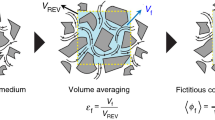Abstract
Effective diffusivity of gases is an important property when modeling the physicochemical processes occurring in a pellet. Calculating effective diffusivity in a pellet composed of a mixture of particles is a difficult task. In this paper, a theoretical model is presented in order to describe the diffusion of gases in a porous pellet made up of a mixture of two kinds of solid grain. Solid grains can either be fully dense and thus non-porous or contain pores, with a grain being sub-divided into sub-grains. The results predicted by the model have been evaluated and validated by use of experimental data obtained by reduction of cuprous sulfide in the presence of lime. Finally, the effects of structural properties and operating conditions on the effective diffusivity of the gases in the pellet have been evaluated.





Similar content being viewed by others
Abbreviations
- b :
-
Number of moles of solid B reacted per mole of gas A in reaction 4
- c :
-
Stoichiometric coefficient in reaction 4
- d :
-
Stoichiometric coefficient in reaction 5
- D Ak,B, D Ak,D :
-
Knudsen diffusivity of gas A in solids B and D, respectively
- D e :
-
Effective diffusivity in the porous solid
- D e,c , D e,s, D e,u,:
-
Effective diffusivity calculated by Sohn and Won and by use of the theoretical model with and without lime sub-structural effect, respectively
- \( D_{{{\text{H}}_{ 2} {\text{ - H}}_{ 2} {\text{O}}}} \) :
-
Molecular diffusivity of hydrogen in water vapor
- D k :
-
Knudsen diffusivity
- D k,c, D k,s, D k,u :
-
Knudsen diffusivity calculated by use of mercury penetration porosimetry and the theoretical model with and without lime sub-structural effect, respectively
- D m,b , D m,c :
-
Molecular diffusivity calculated by Slattery and Bird and by use of the Chapman–Enskog formula, respectively
- E :
-
Stoichiometric coefficient in reaction 5
- F p :
-
Shape factor of the pellet (= 1, 2, and 3 for flat plates, long cylinders, and spheres, respectively)
- F B, F D, F p :
-
Shape factor of grain B, sub-grain D, and pellet, respectively
- M A :
-
Molecular weight of gaseous A
- n d,B, n d,D :
-
Number of solid grains of B and sub-grains of D, respectively
- P :
-
System pressure
- r d,B, r d,D :
-
Average radius of solid grains of B and sub-grains of D, respectively
- r p :
-
Radius or half-thickness of the pellet depending on the geometry
- \( \bar{R} \) :
-
Universal gas constant
- T :
-
System temperature
- α B, α D :
-
Fractions of pellet volume occupied by solids B and D, respectively
- γ :
-
Ratio of the molar quantities of solids B and D, defined by Eq. 11
- ε :
-
Porosity of the pellet
- ρ B, ρ D :
-
True molar densities of solids B and D, respectively
- τ :
-
Tortuosity of the pellet
References
N. Wakao, J.M. Smith, Chem. Eng. Sci. 17, 825 (1962)
E.A. Mason, A.P. Malinauskas, R.B. Evans, J. Chem. Phys. 46, 3199 (1967)
A.B.M. Heesink, W. Prim, W.P.M. van Swaajj, Chem. Eng. J. 53, 25 (1993)
S. Lew, A.F. Sarofim, M. Flytzani Stephanopoulos, AIChE J. 38(8), 1161 (1992)
H. Hassanzadeh, J. Abedi, M. Pooladi Darvish, Comp. Chem. Eng. 33, 133 (2009)
J. Zhang, C. You, H. Qi, C. Chen, X. Xu, Environ. Sci. Technol. 40, 12–4010 (2006)
P.A. Webb, An introduction to the physical characterization of materials by mercury intrusion porosimetry with emphasis on reduction and presentation of experimental data, micromeritics instrument corp (Norcross, Georgia, 2001)
H.Y. Sohn, S. Won, Metall. Trans. B 16, 645 (1985)
H. Kay, High-temperature refractory metals (Gordon and Breach, New York, 1968)
F. Habashi, R. Dugdale, Metall. Trans. B 4, 1865 (1973)
R. Padilla, M.C. Ruiz, H.Y. Sohn, Metall. Mater. Trans. B 28(2), 265 (1997)
T.R. Mankhand, P.M. Prasad, Metall. Trans. B 13(2), 275 (1982)
J.D. Ford, M.A. Fahim, Metall. Trans. B 6, 461 (1975)
F. Habashi, B.J. Yostos, J. Metals 29(7), 11 (1977)
H.Y. Sohn, S. Won, Trans. Inst. Min. Metall. C 94, 140 (1985)
S. Ghasemi Najafabadi, M.H. Abbasi, A. Saidi, Thermochim. Acta 503–504, 46 (2010)
M.M. Afsahi, B. Abolpour, R.V. Kumar, M. Sohrabi, Min. Pro. Ext. Metal. Rev. Accepted (2011)
M.A. Fahim, J.D. Ford, Can. J. Chem. Eng. 56, 730 (1978)
B. Abolpour, M.M. Afsahi, The first national copper conference (Shahid Bahonar University of Kerman, Kerman, 2011)
J.C. Slattery, R.B. Bird, AIChE J. 4, 137 (1958)
C.R. Wilke, Chem. Eng. Prog. 45, 218 (1949)
R.C. Reid, J.M. Prausnitz, T.K. Sherwood, The properties of gases and liquids, 3rd edn. (McGraw-Hill, New York, 1977)
S. Won, H.Y. Sohn, Metall. Trans. B 16, 163 (1985)
H.Y. Sohn, S. Won, Metall. Trans. B 16, 831 (1985)
Acknowledgments
The authors are thankful to Professor H. Y. Sohn for his useful comments. The authors used his experimental data related to hydrogen reduction of cuprous sulfide in this research to validate the model. The authors express their sincere gratitude to him.
Author information
Authors and Affiliations
Corresponding author
Rights and permissions
About this article
Cite this article
Abolpour, B., Mehdi Afsahi, M. & Vasant Kumar, R. A novel theoretical model for calculating the effective diffusivity of gases in a porous pellet composed of two different grains. Res Chem Intermed 38, 1455–1465 (2012). https://doi.org/10.1007/s11164-011-0476-7
Received:
Accepted:
Published:
Issue Date:
DOI: https://doi.org/10.1007/s11164-011-0476-7




